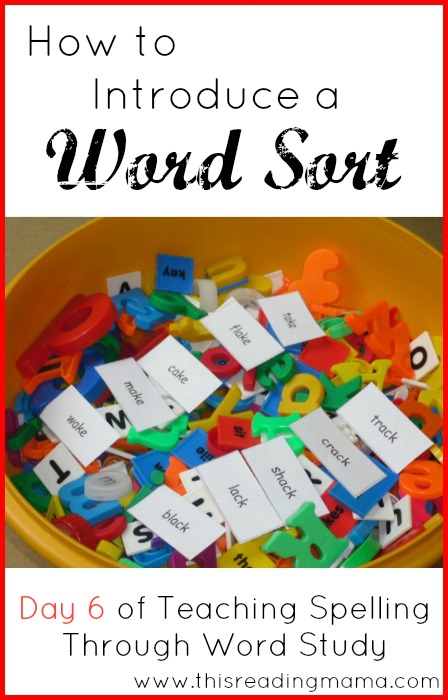 Welcome to This Reading Mama! If you’re joining me for the first time, I’m smack dab in the middle of a series on Word Study, joining some amazing bloggers in iHomeschool Network’s Hopscotch! I’m so glad you’re here. If you missed Days 1-5 of Teaching Spelling Through Word Study, feel free to click on the above picture or here and get caught up! 🙂
Welcome to This Reading Mama! If you’re joining me for the first time, I’m smack dab in the middle of a series on Word Study, joining some amazing bloggers in iHomeschool Network’s Hopscotch! I’m so glad you’re here. If you missed Days 1-5 of Teaching Spelling Through Word Study, feel free to click on the above picture or here and get caught up! 🙂
This week, we’re moving beyond theory to more practical stuff and I’m excited! Today, I’m going to focus on introducing a word sort to your child. Please note: introducing word sorts can look different, depending upon the level of the child. For a more word sort introductions, check out Amy’s lesson with her son or the -at family sort with ALuv (at a Kindergarten level). For my purposes today, we’ll use the same word sort that I gave as an example last week, long a (ai versus ay) – you can also click on this link to read more about word sorts.
1. Copy and Cut Words Apart
The sort will look something like this when you first copy it off. You can cut apart the words or ask your child to do it.
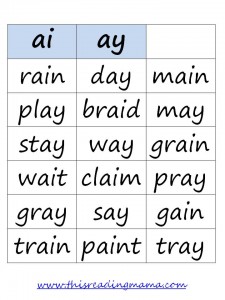 If your child is unfamiliar with the concept of sorting, you may want to introduce what sorting is by using a laundry example: darks, whites, etc. or putting away silverware: forks go here, knives go here, etc.
If your child is unfamiliar with the concept of sorting, you may want to introduce what sorting is by using a laundry example: darks, whites, etc. or putting away silverware: forks go here, knives go here, etc.
2. Introduce the Patterns
Mama: “You know one way to spell words that have the long a sound in them: A_E. Well, today we’re going to sort some words that also have the long a sound, but we’re going to see that they don’t have a silent e.”
As I say all this, I place the head pattern cards at the top of the workspace.
3. Introduce Head Words or Familiar Words
I pre-pull one AI word that he knows by sight and one AY word that he already knows by sight to use as examples. I place those under the AI and AY patterns.
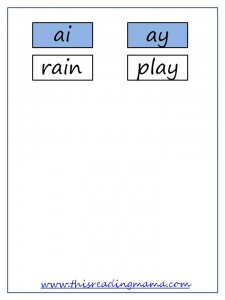 Mama: “You already know this word. Read it to me, please.”
Mama: “You already know this word. Read it to me, please.”
Child: “Rain.”
Mama: “And you know this word, too.”
Child: “Play.”
Sometimes, I’ll even underline the pattern within the head words to bring extra attention to it.
4. Sort All the Words by their Visual Pattern
Mama: “We’re going to sort all the words here by either having an AI or an AY in them.” I may sort a few myself first and then give this over to the child, providing support if needed, such as, “Does that word have an AI or an AY? Where would you put it?”
The finished sort will look something like this:
5. Focus on the Sounds of the Patterns
Mama: “Now that all our words are sorted by their pattern, let’s talk about the sound of these patterns. What sound does the AI make in the word rain?” Child: “a”. If child struggles, I might say the word like this /r-a-a-a-a-n/, really emphasizing that long a sound.
Mama: “Yes, it makes the /a/ sound. So, let’s go through the words on the ai side and read them together, remembering that the ai is going to make the /a/ sound.” I am ready to jump in and provide support whenever needed. For example, if the child gets confused or struggles with the word main, I could use this hint, “It rhymes with the head word rain.”
Go through the AY column and read all the words together.
6. Introduce Vocabulary
Within any given word sort, there may be words that are unfamiliar to students in their meaning. While the child may be able to decode the word, the meaning is unknown. For this sort, I would probably discuss the meaning of these particular words: braid (especially if the child is a boy), grain, claim, pray and tray. For further tips on introducing vocabulary words, click here.
7. Form Generalizations
Instead of focusing on rules (which are often broken in the English language), word study focuses on making generalizations. You can read more about this here.
Mama: “None of these words have a silent e, do they? What are the two other patterns we saw today that make the long a sound?” Child: “AI and AY.”
Mama: “Yes, these are two more ways to spell the long a sound. Did you notice where in the word all the AI’s are?” Child: “In the middle.”
Mama: “In the middle…that’s right. Sometimes, AI can also be at the front of a word. What pattern do you notice when the long a sound comes at the end of the word?” Child: “AY.”
Mama: “That’s right. So, how do you know when to use AI or AY when you’re spelling a word?” Child: “If I hear the long a in the middle, I spell it AI and if I hear it at the end, I spell it AY.”
7. Child Re-Sorts Independently
Mama: “Very good. Now, I’m going to shuffle up the words and let you resort them by yourself.” I am ready to provide extra support, if needed. “Once the words are sorted, I want you to read them to me one more time.”
8. Copy the List / Write the Generalization Learned
Depending upon the age of your child, you can then have that child copy the sort into some kind of spiral bound notebook. He can take it a step further and write the generalization he learned about those patterns as well. This sort’s generalization could sound something like: AI comes at the beginning or in the middle of words and AY comes at the end of words.

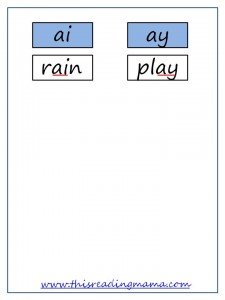
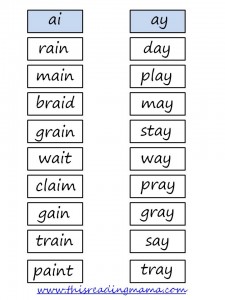
I would like to thank you for ALL of the incredible information on your site. I just finished reading your book, “Teaching Your Kids To Spell,” and I feel way more competent in my ability to teach my child how to spell. I have spent about 3 days, off and on, going through your site, your resources and reading your book and it’s been the most informative information I have found. Period. Thank you for your time and commitment in helping others. You are truly a blessing!
Thank you, Emily! That means so much!